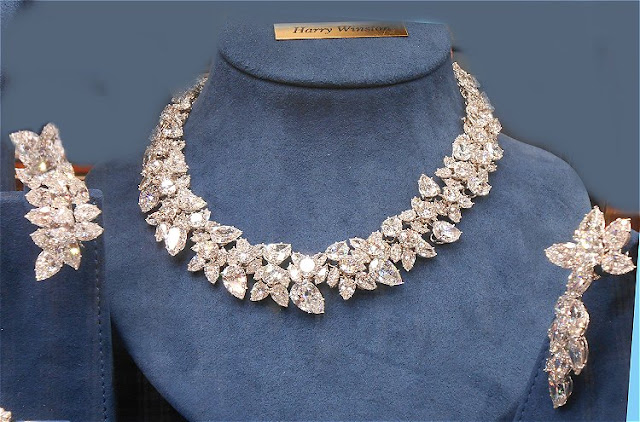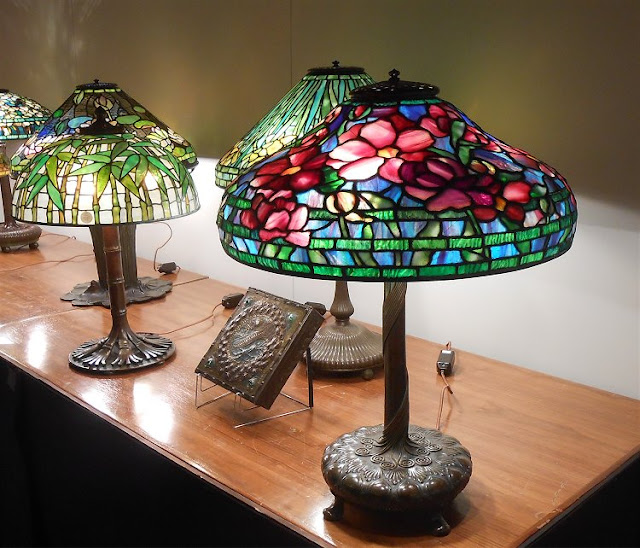Callaghan's of Shrewsbury, England, offered paintings and realistic animal sculptures.
Richard Smith specializes in rabbits and has developed techniques for making
the patinas on his sculptures look exceptionally real.
Across the aisle was Steinitz Artworks. They bring several complete rooms with them; the
walls and floors, as well as the objects are for sale. The carved wood wall panels are from
a great house in Britain. The classical heads are mounted on Renaissance marble busts.
Another room at Steinitz features primarily Chinese art. Notice here the hand-painted
chinese wallpaper, the inlaid floor, the Chinese vessels all around the room, and the
cloisonné table in the center.
This piece is exceedingly rare. To make this tabletop, the artist had to first solder the threads of
copper you can see throughout the work. The little fields thus made were then filled with
ground up glass, and the whole was put into a furnace to fuse the glass enamel to the
copper backing. This was extremely time consuming, and the table was probably made
for the emperor, since the dragon has 5 claws, a symbol reserved for only the emperor.
The top of a side table showing top quality work in three styles. The bird and branches are
made in pietra dura (different colored large pieces of stone sliced thin), surrounding them are very ting pieces in micro-mosaic, and finally the outer sections have larger pieces of regular
mosaic. Such a piece was probably made in Rome and probably in the papal workshops,
which made the finest mosaics and micro-mosaics in the 17th-18th centuries.
Another view of the Chinese Room at Steinitz.
The cabinet is notable for its ormolu mounts and the three inlaid panels in the doors.
These are all made of pietra dura, different kinds and colors of stone cut to make
the forms.
Cabinet with clock, screen, and candlelabra.
These were at Butchoff Antiques.
A table top made with dozens of varieties of rare stones.
This dealer specializes in ancient Chinese art and Lalique glass.
The ceramic horse is a tomb figure from the T'ang Dynasty of the 9th century, as are
the attendant figures on the far right.
An 18th century French gilt clock with enamel panels of flowers.
They are surrounded with Persian carpets.
Mellio Gallery specializing in classical busts and Neo-Classical sculpture.
The entrance to the Butchoff Antiques display.
Callaghan's of Shrewsbury features many animals in bronze, especially by Tobias Martin
and Richard Smith. There were also a couple of other sculptors' work.
Tobias Martin bronze sculptures.
Bronze animal sculptures.
St. Roch, patron of those with the plague. Mexican, 17th century, wood.
His symbols are the seashells (showing he was a pilgrim to Santiago Compostela) and
the wound on his leg( concerns one of the stories of his miracles).
His symbols are the seashells (showing he was a pilgrim to Santiago Compostela) and
the wound on his leg( concerns one of the stories of his miracles).
He might be very useful this year. Behind him to the left is a lacquer box, a blue and
white porcelain vase, and a multi-colored vase from China.
A French commode with two 19th century Impressionist scenes.
There were also American antique dealers. This is a 19th century weather-vane.
American chest of drawers and two weather-vanes.
Greg Pepin had a fine display of silver by Georg Jensen and Lous C. Tiffany,
among others.
Nearby was a display of large silver center-pieces.
And always close at hand was a jeweler. Here is a beautiful
ruby and diamond necklace.
Sapphire and Diamond Necklace
Van Cleef and Arpels Yellow and White Diamond Necklace.
Dealers are both primary and secondary. Primary design and make their own jewelry;
secondary sell jewelry made by many sources over the years.
Dealers are both primary and secondary. Primary design and make their own jewelry;
secondary sell jewelry made by many sources over the years.
Emeralds and Diamonds Necklace
A diamond necklace by Harry Winston.
There were three dealers in Oriental rugs. They were all extremely knowledgeable about
materials, processes, and images. I don't know much, so I had questions. This is a
dealer from Atlanta, GA. There were carpets from Persia, China, Turkey, and elsewhere.
The brighter colors tend to be the newer ones. The gentleman on the left is from Iran.
A carpet dealer from Istanbul, Turkey; I have met him before, very nice. The far left carpet is
from China and is all silk, the purple one to the right is silk and wool. The geometric
patterns are traditional Persian patterns.
A modern Persian carpet in very delicate colors.
An 18th century traditional Persian carpet with geometric and floral motifs.
Boccara Gallery specializes in modern tapestries, usually designed by famous artists.
This large tapestry, "The Black Serpent," was about 10 feet long and designed by the French
artist of the early 20th century, Sonia Delaunay.
Adolph Gottlib, "Golden Orb," is a very interesting and large
work derived from his painting. 8 x 10 ft
This was the most contemporary piece, designed by the French
Graffiti artist, Jonone. His murals are on Wynwood walls and his
paintings are in galleries all over. This is "Waterfall."
8 x 10 ft.
_


































































